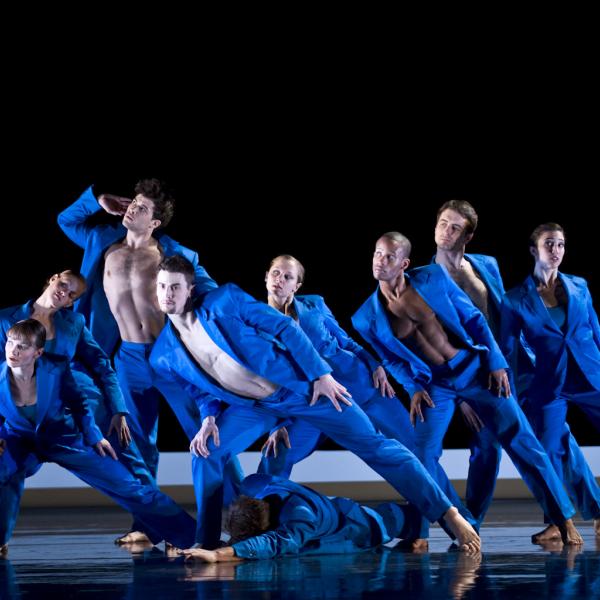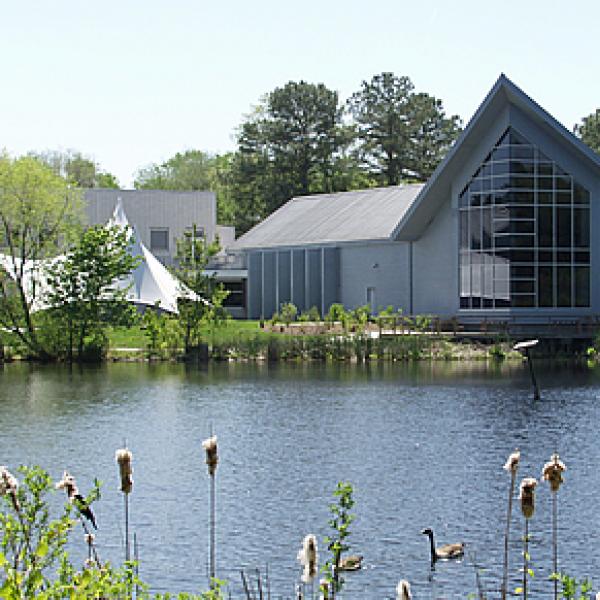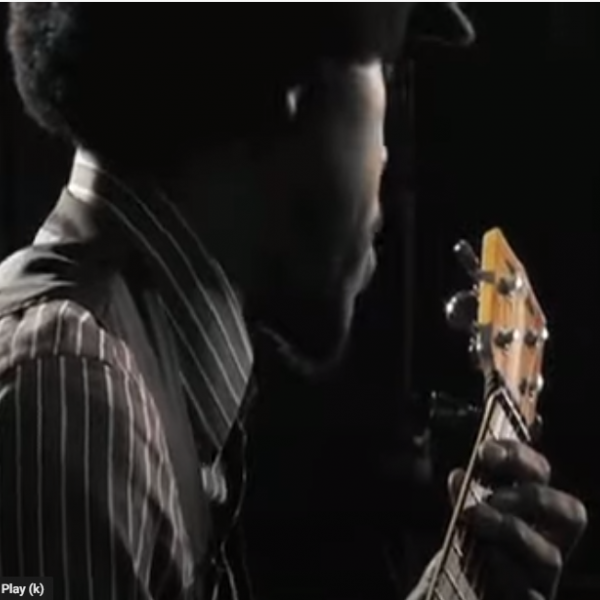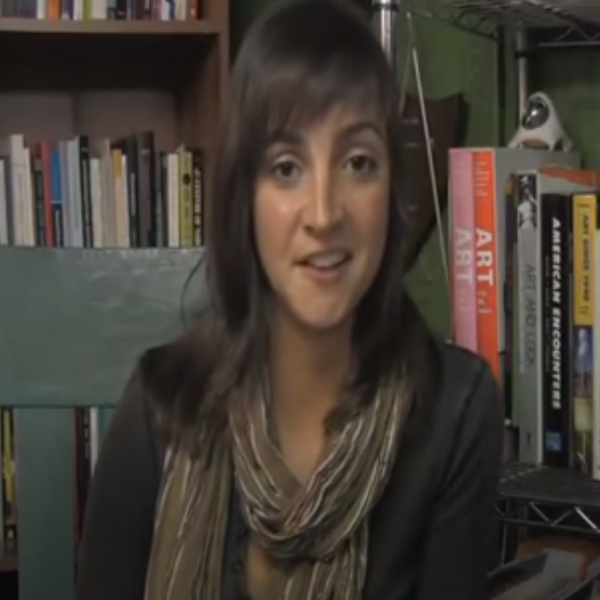Lead Pencil Studio and the Spaces Within

Arrival at 2AM, 2007, by Lead Pencil Studio, a spatial recreation of the shape of moon rays as they would enter the gallery from two fictional windows at 2 a.m. once per year.
All photos courtesy of Lead Pencil Studio
Things you expect to see at a border crossing: fences, contraband-sniffing dogs, stern warnings. Things you don't expect to see: a 30-foot-tall, 50-foot-wide, woven metal sculpture that looks a lot like a billboard. Except where you expect to see an ad for fast food, there is literally nothing but sky. Non-Sign II, commissioned by the federal General Services Administration (GSA), is a sculpture by Seattle-based partners Annie Han and Daniel Mihalyo, collectively known as Lead Pencil Studio. Like much of their work, Non-Sign II evidences the art and architecture duo's preoccupation with the framing and partitioning of space in order to direct the viewer to a new way of seeing.
As Mihalyo explained, their pieces are "sort of wedged between architecture -- the practical art form -- and artwork, which is a less practical form of creativity." It's this wedge-shaped space that he and Han find irresistible. "Why shouldn't there be a whole realm of architecture that's nonfunctional…and really just meant for experiencing space for its own sake with no practical purpose whatsoever?"
Having received several notable distinctions in recent years -- including the 2007/08 Rome Prize for Architecture from the American Academy in Rome -- Lead Pencil Studio has already established itself as a significant presence in the field. Yet Han, 43, never expected to grow up to be an artist nor an architect. Korea-born Han explained that only the wealthy or precociously talented received art lessons in her native country. Her horizons changed when she emigrated to the U.S. at age 15. "I was put into eighth grade and right away the teacher picked me out of the class and encouraged me to do artwork," she recollected. Still, despite her artistic promise, her parents encouraged her to choose a more practical college major. Han enjoyed writing, so journalism seemed a promising career path. But, she acknowledged laughingly, "I practically flunked out of journalism school the first year." Impressed by her talent for drawing, a friend suggested Han give architecture a try instead.

Lead Pencil Studio founders Annie Han and Daniel Mihalyo. |
Mihalyo's road to architecture started in Seattle, where, he said, "the public school system had really good art teachers all along. I took a lot of art and theater and drafting and design classes." As an undergrad at Western Washington University, he spent much of his time in the art department under the mentorship of Japanese sculptor Katsumi Murakami. Mihalyo interned with Murakami that summer in Japan on a public art commission. After taking some time off from school, he decided to switch his major to architecture, transferring to the University of Oregon.
It was in the University of Oregon's School of Architecture that Han met Mihalyo, who is three years her junior. She was a teaching assistant for one of his classes, and they started to work on projects together -- such as Mihalyo's designs for lowincome housing in Eugene, Oregon -- falling in love in the process.
The university's architecture school was ideal for a duo also interested in the arts. According to Mihalyo, "It was an unusual program that had a dual emphasis in the arts and in architecture, so architecture students were encouraged to take their electives in art and vice-versa."
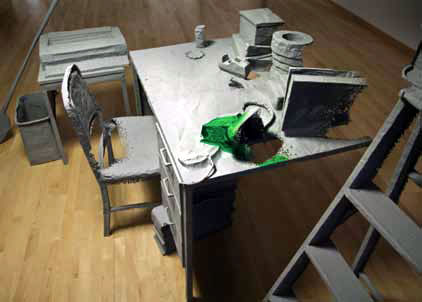
A detail from Surface Deposit, 2010, a site-specific installation for Temple Gallery at Tyler School of Art in Philadelphia, Pennsylvania. |
Not only did their time at the university foster their interest in both modes of working, but they also learned fairly quickly how to collaborate with each other. One of their ground rules is that they start each project with a completely blank slate, rather than with individual sketchbooks of ideas. They also spend a lot of time simply talking about the project. Han explained, "We [ask] what are some words and things that come to our minds, and we write those things down. Then we go through our archives of research we've done, photographs we've taken…and then we start developing ideas." Whether working on a traditional architectural project or a visual arts-based work, Mihalyo and Han are careful to only take those projects by which they are truly inspired, whether that provocation is a particular site or institution or place. "We're going to have to make sure we're inspired by it. If we're not, then I don't feel like we do our best work."
Lead Pencil's thoughtful approach to work is evidenced by the backstory behind Non-Sign II. The installation is situated at the U.S.-Canada border crossing near Vancouver. The artists had to consider that the audience would have only a few minutes to take in the sculpture, would be in a moving vehicle as they viewed it, and that it would most likely be seen multiple times by drivers who use the route for commercial reasons. There was also no way to control the weather conditions under which the sculpture would be viewed. In addition to practical concerns, the team wanted to use the opportunity to comment on contemporary highway billboard culture, as well as to highlight commerce as a primary relationship between the U.S. and Canada.
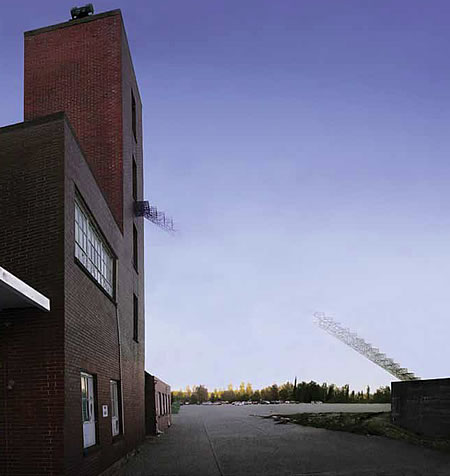
Stairway, 2003, a sculpture of welded steel, was a site-specific temporary installation in Seattle, Washington, commissioned by the Sand Point Arts & Cultural Exchange. |
Han noted that one of the project challenges was to get the viewers to take notice of the beautiful tidal landscape surrounding them even as they underwent the scrutiny of a border crossing. "There's this other world that's sort of operating that you're not aware of, and we want to push viewers' experience back out into the world beyond. That's part of the reason we decided to create an aperture that refocused on the world that's behind all this artificial world."
Mihalyo and Han are both quick to praise former GSA Art in Architecture Director Susan Harrison for creating a supportive work environment around the installation. "It was a real joy to work on that project so we were really happy and proud that our government had set up a system for that to happen and to take place so effortlessly," enthused Mihalyo.
While Lead Pencil Studio's visual arts portfolio is impressive, they are also very much practicing architects. In fact, the couple's own home -- a reclaimed vacant lot just outside of downtown Seattle -- was featured in contemporary design mag Dwell. As Mihalyo described, they typically work on "small commercial projects for clients in the creative arts, including commercial art galleries, record companies, and ad agencies." Lead Pencil has also worked on residential projects, including mixed-use housing.
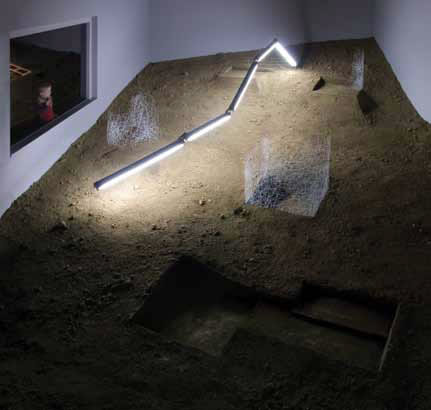
Stairway, 2003, a sculpture of welded steel, was a site-specific temporary installation in Seattle, Washington, commissioned by the Sand Point Arts & Cultural Exchange. |
The influence of the couple's architectural practice on their visual arts work is quite apparent. Not only is there a common vernacular -- the skeletal scaffolding of their sculpture Maryhill Double, or the window of their sculpture Adoration Turning Yellow, for example -- but there is a preoccupation with getting the viewer to consider space in a specific way. As Mihalyo expressed, "Almost everything we are trying to address in our art work is coming from our observations and our experience about buildings and build culture and cities and that type of thing." He added that while their fine arts practice borrows the language of architecture, in many ways it's also about contravening the rigidity of the discipline.
The influence of their sculpture on their architecture may be less explicit, but it's no less present. Han used the metaphor of drawing with a pencil to try and pin down how their art practice ultimately relates to their architectural one. "If you're used to drawing perfect lines with a ruler and then someday somebody shows up and says, 'Okay, don't use the ruler,' you have to be really conscious about the thickness of the pencil you're going to use, how much pressure you're going to put on. So it frees you from certain rule-bound disciplines and at the same time makes you very aware of the gestures that you're making. So for architecture, we try not to fuss over some things. We can step outside of that and think of the bigger picture, which is the beauty of space."
Ultimately, Lead Pencil Studio is after the same result whether working in fine art or architecture: to draw an emotional response from the viewer. Han said that she likes to ask friends about the "most meaningful spatial experience they can describe….It takes a while for people to think about that and then it's sort of the brief experience that you almost can't describe. It's like falling in love for the first time. I feel like if we have enough of that [feeling] in a spatial experience, then we would expect our built environment to be better."
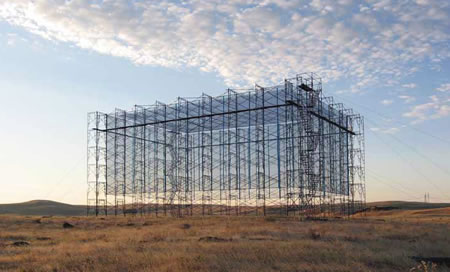
Maryhill Double, 2006, is a site-specific installation along Oregon's Columbia River Gorge, the exact spatial duplicate of the Maryhill Museum across the river. |


